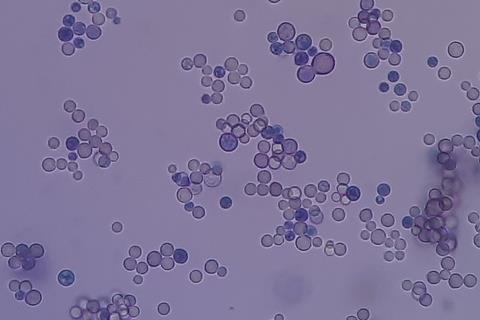For the roughly 150,000 AIDS patients who come down with a life-threatening infection called fungal meningitis each year, there aren’t many options.
In many parts of the world there’s only one treatment available: a drug called fluconazole that works for less than half of patients. That’s as good as it gets.

Now, a study led by Duke University researchers suggests there may be a way to improve the odds – simply by changing what patients eat.
In animal tests, the researchers found that taking fluconazole in combination with a low-carb, high-fat keto diet worked significantly better at killing the fungus than taking the medication alone.
Simple and effective
The same effects have yet to be shown in humans, the researchers caution. But the results, published April 15 in the journal mBio, could point to a simple way to make an essential medicine more effective, particularly in areas where no other alternatives exist.
“This could be an inexpensive way to take a mediocre treatment and actually make it better, especially for patients who don’t have other options,” said senior author John Perfect, a professor of medicine and the Chief of Infectious Diseases at Duke.
Despite its recent rise in popularity, the keto diet isn’t new. Physicians have been using this largely fat-based diet for over a century to treat epilepsy in children whose seizures didn’t respond to medication.
For the new study, the researchers wondered if a keto diet – which deprives the body of glucose by cutting carbohydrate foods – might help starve the fungus and make it more vulnerable to treatment without hurting its host.
Ketogenic diet
They did a series of experiments in mice, feeding some of them a ketogenic diet in which 75% of their calories came from fats like lard, butter and corn oil for 10 days. The rest were fed standard lab chow consisting of grains and proteins like ground corn and soybeans and only 6.5% fat.
The shift put the keto-diet mice into ketosis: a metabolic state where the body burns fats for energy instead of glucose.
Next the mice were infected with Cryptococcus neoformans, the yeast that causes fungal meningitis, and treated with either fluconazole or a placebo.
After five days, the researchers measured how much of the fungus was still in the animals’ bodies to see how well the treatments worked.
Potent mix
On its own, the keto diet did nothing to kill the fungus or stop infection. But the keto diet combined with fluconazole made for a potent mix.
Within a week of starting treatment, fluconazole alone reduced the levels of fungi in the mice by roughly 10- to 100-fold. But when taken in combination with a keto diet, the drug dropped the mice’s fungal levels by as much as ten thousandfold.
“We saw a really dramatic additional decrease in fungal burden in the combination group,” said first author Julia Palmucci, a Ph.D. candidate in molecular genetics and microbiology at Duke.
Fluconazole boost
After several days on fluconazole, mice in the keto group had significantly lower levels of fungus in both their brains and lungs than mice on a conventional diet.
What’s more, a small dose of the drug taken on a keto diet was as effective as a fivefold higher dose taken on a standard diet.
The effects weren’t restricted to Cryptococcus infections, either. The keto diet also made fluconazole more potent against another potentially life-threatening infection, caused when a yeast called Candida albicans enters the bloodstream.
Together with Cryptococcus neoformans, the two pathogens are among the top fungal threats to human health, according to the World Health Organization.
Dietary shift
The researchers aren’t exactly sure why mice in the keto group respond better to fluconazole.
It’s possible that a keto diet influences the gut microbiome in a way that changes how the drug is absorbed. The dietary shift could also boost the immune system, making it easier for the drug to control infection. But further research is still needed pin down what’s going on, Palmucci said.
To see how quickly the effect kicked in, the researchers also started some mice on a keto diet 24 hours after they got infected, and found they did just as well on fluconazole as mice that started the diet 10 days beforehand.
“It’s a promising result because most people who come to the hospital with invasive fungal infections are not going to be already on a keto diet,” Palmucci said.
Human trials needed
This doesn’t mean that the next time you get a toenail infection, you should try cutting carbs and filling up on fats while you take your meds, she added.
While the keto diet shows promise in enhancing fluconazole’s effects in mice, there’s no guarantee it would work in people. For that we would need well-designed, well-controlled human clinical trials, and those are still a ways off, Perfect said.
One thing is certain: The threat of fungal infections is growing, as fungi either evolve ways to evade drugs that once worked, or pop up in places they haven’t been seen before.
“We have limited antifungal drugs, and there haven’t been any new ones for about 20 to 25 years,” Perfect said.
Optimizing the drugs we have
Until new antifungal drugs are available, he added, this could be a way “to optimize the drugs we have.”
Fluconazole is on the World Health Organization’s List of Essential Medicines. Since its patent expired some 20 years ago, generics have been available worldwide at low cost, making it relatively inexpensive compared to other antifungals.
“As my grandmother once said, ‘you are what you eat,’” Perfect said. “But in this particular situation, what you eat could potentially be used to make antifungal treatments better.”
This research was supported by the National Institute of Allergy and Infectious Diseases at the National Institutes of Health (AI73896, AI93257) and the Duke University School of Medicine.







No comments yet